 As early as April 19, 1861, President Lincoln decreed the blockade of the coasts of the seceding states . This decree authorized Union ships to board any ship entering or leaving a rebel port. Initially, it was a reaction to a decision by the Confederate government, which threatened to grant letters of marque to privateers, authorizing them to attack Union ships. During the summer of 1861, the blockade fitted perfectly into General Scott's "Anaconda plan". From August, the first operations aimed at strengthening it were undertaken.
As early as April 19, 1861, President Lincoln decreed the blockade of the coasts of the seceding states . This decree authorized Union ships to board any ship entering or leaving a rebel port. Initially, it was a reaction to a decision by the Confederate government, which threatened to grant letters of marque to privateers, authorizing them to attack Union ships. During the summer of 1861, the blockade fitted perfectly into General Scott's "Anaconda plan". From August, the first operations aimed at strengthening it were undertaken.
A titanic job
It's a gigantic task ahead of the U.S. Navy. The coasts of the southern states alone represent a development of more than 5,000 kilometers . Faced with this, the Federal Navy had only 42 ships in service. Another 48 vessels were held in reserve, but the majority of these were old sailboats, whose operational utility would be limited. During the first months of the war, the Department of the Navy therefore supported a considerable effort to increase its manpower, buying many civilian ships in order to arm them. New constructions of modern vessels, steam or even battleships, will also be launched. In 1865, the number of ships in service will exceed 600.
The northern blockade focused first on where it was easiest for them. Thus, the Monroe fortress, which controlled the channel of Hampton Roads, made it possible to very quickly block the port of Norfolk , as well as the estuary of the James River, which led directly to the Confederate capital, Richmond. The Union having also kept Fort Pickens, it was thus able to block – in part – Pensacola, Florida. Relatively close to northern ports, North Carolina was therefore, quite logically, the next target of the federal navy.
Its sandy shores featured countless estuaries and inlets that joined to form two main bays, Albemarle Bay and Pamlico Bay. However, they were separated from the Atlantic by a chain of stretched islands and sandbars which closed them off almost completely. Communications with the high seas could only be made through a few channels which were relatively easy to control. These characteristics had not escaped the Confederates, who very quickly undertook to fortify these hotspots.
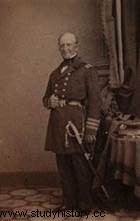 To gain access to the Carolinian shores, the Union Navy decided in August 1861 to aim the Hatteras Channel , to the southwest of the island and the cape of the same name. The Confederacy had hastily established two forts there, baptized Clark and Hatteras, held by a few sailors and the 7
th
North Carolina Regiment. To seize it, the northern navy assembled a flotilla of seven warships, two transports and a tug, which it entrusted to Captain Silas Stringham. The army contributed to the expedition by providing a small brigade, detached from General Butler's troops at Fortress Monroe – the latter assuming command himself.
To gain access to the Carolinian shores, the Union Navy decided in August 1861 to aim the Hatteras Channel , to the southwest of the island and the cape of the same name. The Confederacy had hastily established two forts there, baptized Clark and Hatteras, held by a few sailors and the 7
th
North Carolina Regiment. To seize it, the northern navy assembled a flotilla of seven warships, two transports and a tug, which it entrusted to Captain Silas Stringham. The army contributed to the expedition by providing a small brigade, detached from General Butler's troops at Fortress Monroe – the latter assuming command himself.
The northern squadron arrived in sight of its objective on August 27 and began shelling Fort Clark the following day. Stringham employed a relatively new tactic , made possible by the advent of steam navigation:he led the bombardment on the move, greatly reducing the effectiveness of fire from southern coastal batteries. Moreover, the latter, due to their isolated position, could not be easily reinforced and even less resupplied. By midday, Fort Clark had run out of ammunition, and had to be evacuated.
Stringham then turned to Fort Hatteras, but bad weather gave the defenders respite, allowing them to save their shells and receive some reinforcements from nearby islands. The squall soon dissipated, however, and the Union ships returned the next day, August 29. Stringham quickly realized that Fort Hatteras did not have a gun carrying far enough to retaliate effectively. This time he anchored his ships, which unleashed their firepower on a sluggish enemy. After a few hours of this treatment, Fort Hatteras capitulated, leaving the pass in the hands of the Northerners. It was to serve as the base for a later campaign which, during the winter of 1861-62, was to block virtually the entire coast of North Carolina .
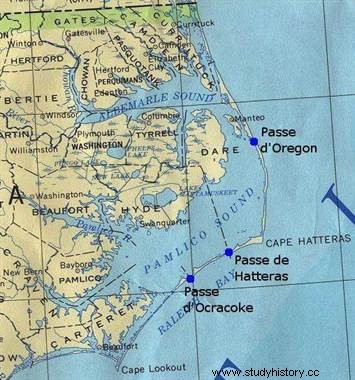
Map of North Carolina coastline, with major access points to Pamlico Bay. Source:Perry-Castaneda map library.
The blockade is sliding south
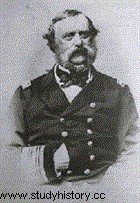 Deemed indefensible, the passes near Ocracoke and Oregon were evacuated by the Southerners, increasing control of the Federals on Pamlico Bay. Over the following months, the blockading ships, organized into three and then four squadrons (North Atlantic, South Atlantic, East and West Gulf of Mexico), gradually made their presence felt outside Confederate ports. Nevertheless, this deployment was not without posing serious logistical problems . Supplying and maintaining these fleets at sea required facilities that the Union had only in its own ports.
Deemed indefensible, the passes near Ocracoke and Oregon were evacuated by the Southerners, increasing control of the Federals on Pamlico Bay. Over the following months, the blockading ships, organized into three and then four squadrons (North Atlantic, South Atlantic, East and West Gulf of Mexico), gradually made their presence felt outside Confederate ports. Nevertheless, this deployment was not without posing serious logistical problems . Supplying and maintaining these fleets at sea required facilities that the Union had only in its own ports.
While steam navigation had its advantages, it also had the disadvantage of making ships dependent on their coal supplies. The machines of the time consuming large quantities, it was necessary to save it by using the sails when possible, and to return regularly to the port to refuel the holds. The Union therefore needed a coal mining in the first place. , as much as a naval base, in southern waters. At the end of 1861, an operation to seize such a base was planned.
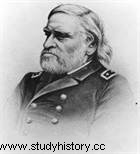 This is Port Royal Bay who was chosen. Located in South Carolina, halfway between Charleston and Savannah, it had several advantages that made it the ideal site. Cut by numerous channels and islands, it was however large enough to accommodate a large fleet. Its very width made it difficult to defend from the sea, while conversely, the marshy areas that surrounded it protected it from a counterattack by land. Swamps that would significantly impede the delivery of reinforcements and supplies to southern defenders. Once masters of the place, the northern troops would not have this problem, since their naval superiority would guarantee their lines of supply.
This is Port Royal Bay who was chosen. Located in South Carolina, halfway between Charleston and Savannah, it had several advantages that made it the ideal site. Cut by numerous channels and islands, it was however large enough to accommodate a large fleet. Its very width made it difficult to defend from the sea, while conversely, the marshy areas that surrounded it protected it from a counterattack by land. Swamps that would significantly impede the delivery of reinforcements and supplies to southern defenders. Once masters of the place, the northern troops would not have this problem, since their naval superiority would guarantee their lines of supply.
The Confederates did not remain inactive, however, building forts Walker and Beauregard on the bay. A garrison of 3,000 men was entrusted to Thomas Drayton, while the southern navy had gathered at Port Royal a flotilla comprising four small gunboats under the command of Josiah Tattnall. The Northern Expedition was much larger:General Thomas Sherman had been entrusted with a force of 12,500 men divided into three brigades. These troops were transported by a fleet of 77 buildings, including 19 warships. The naval element was commanded by Samuel Du Pont, whose uncle – of French origin – had founded a company manufacturing gunpowder and was destined to become the chemical giant Du Pont de Nemours.
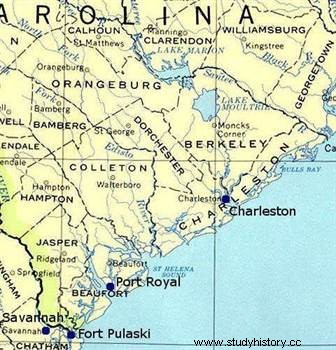
Map of South Carolina coastline. Source:Perry-Castaneda map library.
The Battle of Port Royal
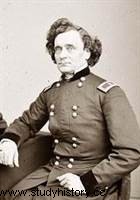 The northern squadron set sail on the 1
st
november. Poorly concealed, its objective was soon known to all, friends and enemies alike, through the press. To this indiscretion another annoyance was added, a storm sinking one of the transport ships and dispersing the rest of the fleet, which took several days to regroup at the entrance to the bay of Port Royal. During this time, the southern flotilla of Tattnall came to meet it but, desperately outgunned, it could not prevent the Federals from mapping the bay and even less from preparing their attack.
The northern squadron set sail on the 1
st
november. Poorly concealed, its objective was soon known to all, friends and enemies alike, through the press. To this indiscretion another annoyance was added, a storm sinking one of the transport ships and dispersing the rest of the fleet, which took several days to regroup at the entrance to the bay of Port Royal. During this time, the southern flotilla of Tattnall came to meet it but, desperately outgunned, it could not prevent the Federals from mapping the bay and even less from preparing their attack.
After a first failed attempt on November 6, Du Pont decided not to wait for the arrival of the ammunition transports, which the army needed to land, and to begin the bombardment from the southern forts on the morning of the 7th. Duplicating the tactic pioneered by Stringham at Hatteras, Du Pont opted for a moving bombardment, but misunderstanding soon scattered his fleet, reducing the effectiveness of his fire. The late arrival of the USS Pocahontas gunboat enabled the situation to be rectified. In an irony that only civil wars can produce, this one was commanded by Percival Drayton, the brother of the Southern garrison leader, who had remained loyal to the Union.
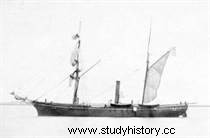 The Pocahontas was not very heavily armed, but she managed to find a firing position that allowed her to enfilade Fort Walker. For the garrison of the latter, the situation ends up becoming untenable. Most of the troops were withdrawn, leaving only a rear guard which, soon running out of ammunition, evacuated the fort in turn. Fearing being taken from behind, the forces holding Fort Beauregard imitated them at the end of the day. On November 8, their empty fort was occupied by Union troops. The Battle of Port Royal ended in a quick and decisive victory for the North.
The Pocahontas was not very heavily armed, but she managed to find a firing position that allowed her to enfilade Fort Walker. For the garrison of the latter, the situation ends up becoming untenable. Most of the troops were withdrawn, leaving only a rear guard which, soon running out of ammunition, evacuated the fort in turn. Fearing being taken from behind, the forces holding Fort Beauregard imitated them at the end of the day. On November 8, their empty fort was occupied by Union troops. The Battle of Port Royal ended in a quick and decisive victory for the North.
The captured base allowed the Union fleet to threaten the entire coast between Charleston and Jacksonville. One could hardly imagine a worse start for Robert Lee, who had just been relieved of his command in West Virginia to head the military department of Georgia and the Carolinas. In spite of everything, he was going to restore his image somewhat. Believing that Charleston, with its three forts and numerous shore batteries, was too well defended for the Union fleet to attack right away, he determined that his next target would be Savannah .
The Siege of Fort Pulaski
That assumption was correct. The town of Savannah, where the troops and the flotilla that had defended Port Royal had taken refuge, was at the mouth of the river of the same name, which marked the border between South Carolina and Georgia. Access to Savannah by sea was defended by Fort Pulaski , a masonry construction completed in 1847. Its thick walls were considered virtually indestructible except when fired at very close range – which, of course, exposed them to destructive fire from the fort's 50 or so guns.
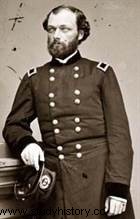 Lee immediately had Savannah put on defense, an exercise in which his habits as a former engineer officer went do wonders. While his men tirelessly dug to erect new batteries, the Northerners closed in. After completely securing Port Royal by occupying the town of Beaufort, Du Pont took his fleet south, arriving in sight of Savannah on 24 November. On the 26th, Tattnall led a new attack with his "fleet-mosquito a nickname that suited him perfectly:his flotilla of improvised gunboats was too small to hope to cause serious damage to Union ships. She therefore contented herself with “whistling in her ears”, before quickly withdrawing to avoid being crushed.
Lee immediately had Savannah put on defense, an exercise in which his habits as a former engineer officer went do wonders. While his men tirelessly dug to erect new batteries, the Northerners closed in. After completely securing Port Royal by occupying the town of Beaufort, Du Pont took his fleet south, arriving in sight of Savannah on 24 November. On the 26th, Tattnall led a new attack with his "fleet-mosquito a nickname that suited him perfectly:his flotilla of improvised gunboats was too small to hope to cause serious damage to Union ships. She therefore contented herself with “whistling in her ears”, before quickly withdrawing to avoid being crushed.
During the following weeks, the northern forces took possession of Tybee Island, which faced the islet on which Fort Pulaski was built. Thomas Sherman, the commander of the Union ground forces, estimated that the effect of the artillery on the fort would be negligible, and planned to amass 10,000 men for a full assault. His chief engineer, Quincy Gillmore, disagreed. Having witnessed the testing of new guns before the war, he was convinced that a bombardment carried out by mortars and modern rifled guns could force the fort to surrender without having to resort to a costly direct attack.
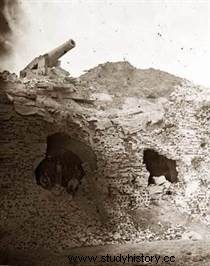 Approach work began on December 20 and continued the following month, disturbed only by harassment operations conducted sporadically by southern gunboats. In March 1862, Thomas Sherman was replaced by David Hunter, who gave Gillmore carte blanche to put his plan into action. At the same time, Lee also left the sector:President Davis had recalled him to Richmond to make him his special military adviser. At the beginning of April, a dozen batteries had been built opposite Fort Pulaski.
Approach work began on December 20 and continued the following month, disturbed only by harassment operations conducted sporadically by southern gunboats. In March 1862, Thomas Sherman was replaced by David Hunter, who gave Gillmore carte blanche to put his plan into action. At the same time, Lee also left the sector:President Davis had recalled him to Richmond to make him his special military adviser. At the beginning of April, a dozen batteries had been built opposite Fort Pulaski.
The bombardment began on the morning of April 10, 1862. All day, the northern and southern guns engaged in an intense artillery duel, but the rifled guns, in particular the 30-pound Parrott, proved as effective as Gillmore had hoped. When night fell, the fort was severely damaged:explosive shells had opened breaches in the walls hitherto deemed impregnable, and even the casemates no longer offered sufficient protection to the fort's guns. When the firing resumed the next day, the shells were quick to devastate the interior, passing through the breaches in the walls and threatening the powder magazine. To avoid unnecessary slaughter of his men, his commander capitulated in the afternoon.
The fall of Fort Pulaski did not mean the capture of Savannah. Indeed, the defenses erected by Lee around the city dissuaded the Federals from attempting to take it. It was not until December 1864 that an offensive from inland took the city. Nevertheless, control of the fort almost completely closed the port to southern shipping. Although other channels allowed a few blockade runners to sporadically reach the open sea or return, with the help of the always enterprising Josiah Tattnall, the blockade of Savannah remained effective for the remainder of the war.
Sources
The proclamation of the blockade
A page on the organization of the blockade
An article on the Battle of Hatteras Pass
An article on the Battle of Port Royal, drawing its sources in particular from the Official Records (reports and official documents of both sides, compiled and published after the war)
Yet another Wikipedia article – about the Battle of Fort Pulaski – but it's full of references and related links. It includes General Quincy Gillmore's report on the siege and bombardment of the fort.
